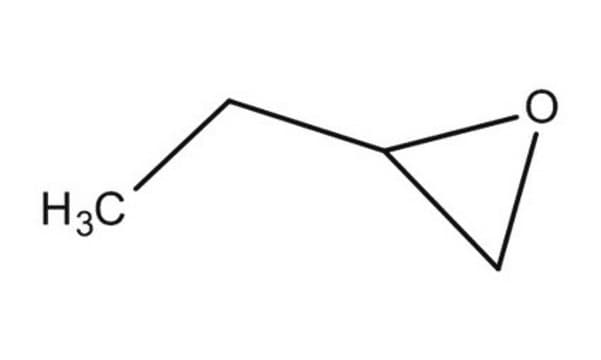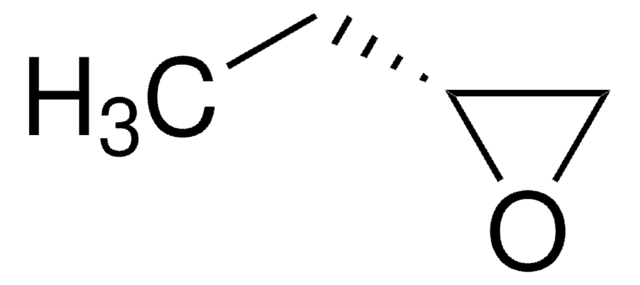109975
1,2-Epoxybutane
99%
Sinónimos:
α-Butylene oxide, 1,2-Butylene oxide, 1-Butene oxide, Ethyloxirane
About This Item
Productos recomendados
densidad de vapor
2.2 (vs air)
Nivel de calidad
presión de vapor
140 mmHg ( 20 °C)
Ensayo
99%
temp. de autoignición
698 °F
lim. expl.
19 %
índice de refracción
n20/D 1.384 (lit.)
bp
63 °C (lit.)
densidad
0.829 g/mL at 25 °C (lit.)
cadena SMILES
CCC1CO1
InChI
1S/C4H8O/c1-2-4-3-5-4/h4H,2-3H2,1H3
Clave InChI
RBACIKXCRWGCBB-UHFFFAOYSA-N
¿Está buscando productos similares? Visita Guía de comparación de productos
Aplicación
- As a monomer to synthesize novel initiators via ring-opening polymerization. These initiators can be used to prepare complex macromolecules such as grafted polyamides.
- To functionalize polyethyleneimine which is used in the synthesis of oxidation-stable adsorbents for CO2 capture.
Características y beneficios
- High polymerizability
- Low susceptibility to transfer reaction
- Ease of handling
Palabra de señalización
Danger
Frases de peligro
Consejos de prudencia
Clasificaciones de peligro
Acute Tox. 4 Dermal - Acute Tox. 4 Inhalation - Acute Tox. 4 Oral - Carc. 2 - Eye Irrit. 2 - Flam. Liq. 2 - Skin Irrit. 2 - STOT SE 3
Órganos de actuación
Respiratory system
Código de clase de almacenamiento
3 - Flammable liquids
Clase de riesgo para el agua (WGK)
WGK 1
Punto de inflamabilidad (°F)
5.0 °F - closed cup
Punto de inflamabilidad (°C)
-15 °C - closed cup
Equipo de protección personal
Eyeshields, Faceshields, Gloves
Elija entre una de las versiones más recientes:
¿Ya tiene este producto?
Encuentre la documentación para los productos que ha comprado recientemente en la Biblioteca de documentos.
Los clientes también vieron
Nuestro equipo de científicos tiene experiencia en todas las áreas de investigación: Ciencias de la vida, Ciencia de los materiales, Síntesis química, Cromatografía, Analítica y muchas otras.
Póngase en contacto con el Servicio técnico














